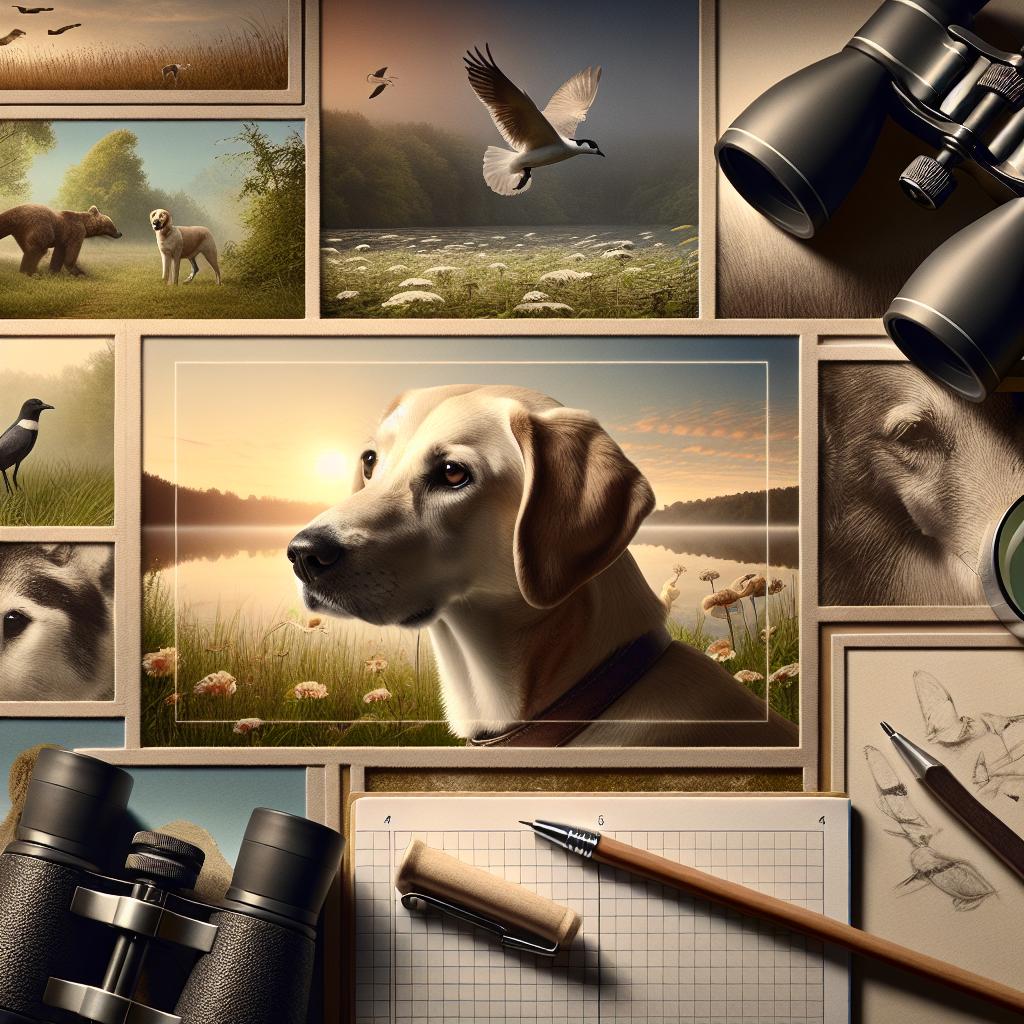in the great tapestry of nature,where wild creatures roam freely and the whispering winds carry the melodies of rustling leaves,our beloved canine companions can sometimes find themselves overwhelmed by the sights,sounds,and scents of the untamed world. for dog owners, particularly those who venture into the great outdoors, the challenge of teaching our pets to exhibit calmness around wildlife becomes not just a matter of obedience, but a vital skill for harmonious coexistence.whether it’s the curious deer peering through the thicket, the spirited rabbit darting across the path, or the majestic bird soaring overhead, fostering a zen-like demeanor in our dogs can enrich their lives and ensure a peaceful surroundings for all.In this article, we will explore practical techniques and mindful approaches to help your furry friend embrace the beauty of wildlife without the impulse to chase or react, ultimately cultivating a bond with nature that is grounded in serenity.
Understanding Your Dogs Instincts in nature
Understanding your dog’s instincts is crucial when it comes to teaching them how to remain calm around wildlife. Dogs are naturally curious and have a strong prey drive, which can lead them to chase after animals they encounter during walks or hikes. This instinct is rooted in their ancestry; wild canines relied on their hunting skills for survival. To aid in this training process, it is essential to recognize certain behaviors that indicate a dog’s instinctual response to wildlife:
- Stalking: A low posture and intense focus on a moving creature.
- Chasing: Immediate pursuit when they spot an animal fleeing.
- Barking: Vocalizing excitement, frustration, or protective instincts.
By understanding these instincts, you can implement effective training techniques that harness your dog’s natural tendencies in a controlled way. Establishing commands that prompt your dog to focus on you instead of the wildlife is essential.Consider these strategies for prosperous interactions with animals in their natural habitat:
| Strategy | Description |
|---|---|
| Desensitization | Expose your dog to wildlife sounds and sights from a distance. |
| Reward-Based Training | Use treats to reinforce calm behavior around distractions. |
| Controlled Exposure | Practice commands in areas where wildlife is present but distant. |

Establishing a Calm Environment for Training
Creating a serene atmosphere is essential when training your dog to remain calm around wildlife. By minimizing distractions, you can help your dog focus on your commands and the training objectives. Start by selecting a quiet, secluded area in nature, away from crowded pathways or noise.Consider the following:
- Choose Timing Wisely: Early mornings or late afternoons frequently enough have less foot and vehicle traffic.
- Use Natural Barriers: Setting up in a location surrounded by trees or hills can provide a natural sound buffer.
- Incorporate Soothing Sounds: White noise machines or nature sounds can definitely help mask sudden wildlife noises.
additionally, ensure that your dog feels comfortable in this space. Bring along their favorite blanket or toys, as familiar scents can calm anxious nerves. Maintain a steady routine during training sessions—organize your commands, treats, and equipment before starting. This consistency enhances your dog’s sense of security and makes the learning process smoother. Here’s a simple checklist:
| Item | Purpose |
|---|---|
| Favorite Toy | Provide comfort and familiarity |
| Training Treats | Reward positive behavior |
| Water Bottle | Keep your dog hydrated |
| Clicker | Mark desired behaviors |

Techniques to Reinforce Calm Behavior Around Wildlife
To foster a sense of calmness in your dog when encountering wildlife, it’s vital to engage in consistent and structured training.Start with basic obedience commands that form the foundation for a well-behaved dog.Teaching commands such as “sit,” “stay,” and “leave it” can greatly enhance your canine’s ability to control impulses when faced with the excitement of wildlife. consider using positive reinforcement techniques; reward your dog with treats and praise for exhibiting calm behavior during training sessions. This approach reinforces the idea that remaining composed leads to positive outcomes.
Along with basic commands,incorporating desensitization exercises can greatly improve your dog’s tolerance to wildlife encounters. Gradually expose your dog to situations that simulate wildlife sightings—start at a distance where they can still maintain their calm, and slowly decrease that distance as they become more comfortable. To aid in this process, using distraction techniques can also be beneficial. Here are a few strategies to consider:
- Use high-value treats to redirect your dog’s attention away from wildlife.
- Engage in play or interactive games when wildlife is present.
- Practice controlled leash walks in wildlife areas.
Moreover, understanding your dog’s body language is essential for fostering calm behavior. Here’s a simple table outlining common signs of relaxation and signs of stress:
| Relaxation Signs | Stress Signs |
|---|---|
| Loosely wagging tail | Tense body or stiff tail |
| Relaxed ears | Flattened ears |
| Soft eyes | Wide eyes or staring |
By recognizing these indicators, you can adjust your training approach accordingly to help your dog maintain a calm demeanor in the presence of wildlife.

Gradually Exposing Your Dog to Natural Settings
Transitioning your dog from the comfort of your home to the great outdoors requires a thoughtful approach. Start with short, controlled outings to nearby parks or trails, where the encounters with wildlife are minimal. Gradually allow your dog to explore these environments while keeping them on a leash. This enables you to maintain control and observe their reactions safely. Pay attention to their body language, and don’t hesitate to reward calm behavior with treats and praise. Some effective techniques for these outings include:
- Rewarding quiet moments when wildlife is nearby.
- Using heavy-duty leashes to prevent sudden escapes.
- Practicing commands like “sit” or “stay” when distractions arise.
As your dog becomes more comfortable, you can slowly increase the frequency and duration of these excursions. Choose locations where wildlife is known to be present but at a distance, allowing your dog the chance to observe without overwhelming them. Gradually introducing more intense stimuli can include visiting places during quieter times of day or using distractions, such as toys or treats, to redirect their focus.Create opportunities for positive experiences in these settings by keeping your outings brief and always ending on a positive note, encouraging a sense of relaxation and calm. consider the following tips to enhance their outdoor experience:
| Tip | Purpose |
|---|---|
| Frequent breaks | To reduce stress and prevent overwhelm |
| Engaging toys | To redirect attention from wildlife |
| Calm demeanor | To model appropriate behavior |
Q&A
Q&A: Teaching Your Dog to Be Calm Around Wildlife
Q: Why is it meaningful for my dog to remain calm around wildlife?
A: Keeping your dog calm around wildlife is essential for several reasons. It helps protect local ecosystems, minimizes stress for both your dog and the animals, and ensures your dog’s safety. dogs that are overly excited or aggressive can not only scare off wildlife but may also provoke hazardous encounters.Q: What are some common wildlife encounters that might occur during walks or hikes?
A: Depending on your location, common wildlife encounters may include rabbits, deer, squirrels, birds, and even larger animals like raccoons or coyotes. Each encounter presents unique challenges, and appropriate training can definitely help your dog respond positively.Q: At what age should I start training my dog to be calm around wildlife?
A: It’s best to start training your dog as early as possible, ideally during puppyhood. However, dogs of any age can learn new behaviors. the key is consistent practice and positive reinforcement to help them build calm associations with wildlife.
Q: What techniques can I use to teach my dog to remain calm?
A: Several effective techniques include desensitization and counter-conditioning. Start by exposing your dog to wildlife from a distance, rewarding calm behavior with treats and praise. Gradually decrease the distance as your dog becomes more comfortable. Additionally,teaching obedience commands like “leave it” or “stay” can be valuable in distracting them from wildlife.
Q: How do I manage my dog’s excitement when we spot wildlife?
A: When you encounter wildlife,remain calm yourself,as dogs often pick up on their owner’s emotions. If your dog becomes too excited, redirect their attention by using treats or toys.Practice commands that reinforce calmness, and reward them when they comply gently.
Q: Are there specific breeds that might be more prone to excitement around wildlife?
A: While any dog can become excited around wildlife, breeds with strong prey drives—such as terriers or hounds—might be more reactive. Understanding your dog’s breed tendencies will help tailor your training efforts effectively.
Q: Can socialization help in teaching my dog to be calm around wildlife?
A: Absolutely! Socializing your dog with other animals and environments is a key component of training. This exposure helps your dog learn how to interact appropriately with various creatures, reinforcing calm behavior even in the presence of wildlife.
Q: What should I do if my dog reacts negatively to wildlife despite my training?
A: If your dog shows signs of aggression or fear, it’s essential to backtrack in training and reassess your approach. Consider consulting a professional dog trainer or behaviorist who specializes in wildlife interactions. They can provide tailored strategies and insights to help your dog learn more effectively.
Q: How can I continue to reinforce my dog’s calm behavior around wildlife over time?
A: Regular practice in controlled situations will help maintain your dog’s skills. Reward calm behavior consistently, and seek out diverse environments where you might encounter wildlife. This ongoing engagement ensures your dog remains desensitized and able to remain calm during actual encounters.
Q: Are there any tools or aids I can use to assist in training?
A: Tools like head halters or no-pull harnesses can provide better control over your dog during encounters. Additionally, having high-value treats on hand can reinforce positive behavior. However, always use tools in conjunction with training techniques rather than as a substitute for proper behavior modification practices.
In Retrospect
cultivating calm behavior in your dog around wildlife is not only essential for your pet’s safety but also for the well-being of the surrounding ecosystem. With patience, consistency, and the right techniques, you can transform your canine companion into a more composed and respectful member of the great outdoors. Remember,every training session is an chance to strengthen your bond and foster a deeper understanding between you and your furry friend. Embrace the journey, celebrate the small victories, and together, let your dog enjoy the beauty of nature without undue excitement. After all, a harmonious relationship with wildlife is a gift that enriches both our lives and theirs. Happy training!

